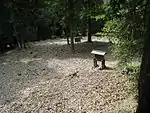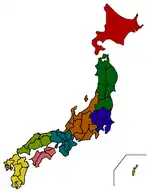Yoshida-Kōriyama Castle
Yoshida-Kōriyama Castle (吉田郡山城, Yoshida-Kōriyama-jō) was a Japanese castle located in Akitakata, Hiroshima Prefecture.
| Yoshida-Kōriyama Castle | |
|---|---|
| Akitakata, Hiroshima Prefecture, Japan | |
 Honmaru compound of Yoshida-Kōriyama Castle | |
| Type | Mountaintop style Japanese castle |
| Site information | |
| Controlled by | Mōri clan |
| Site history | |
| Built by | Mōri Motonari |
| In use | Sengoku period |
| Demolished | 1600[1][2] |
| Battles/wars | Siege of Koriyama (1541) |
| Garrison information | |
| Occupants | Mōri Motonari Mōri Terumoto |
History
Yoshida-Kōriyama Castle was initially built as a small castle in Aki Province in the 14th century, but was later expanded into a large castle by Mōri Motonari, a famous daimyō of the powerful Mōri clan, in the 16th century during the Sengoku period.[3][4] The Mōri originally came to the Yoshida area from Sagami Province (now Kanagawa Prefecture) in 1336. Having survived the war during the Nanboku-chō period (14th century), they continued to expand their territories in the Chūgoku region.[5]
For much of the early Sengoku period, the castle was small, and the Mōri found themselves vulnerable, wedged between the Ouchi clan of Suo Province and the Amago clan of Izumo Province.[4] In September 1540, the Amago besieged the castle at the Siege of Koriyama, but the Mōri defeated them with Ouchi assistance in January 1541. Mōri Motonari first defeated the Amago with the help of the Ouchi, and then defeated the Ouchi after they were weakened by internal conflict.[5] The Mōri became more influential, and extended its holdings to cover most of the Chugoku region.[3] Yoshida-Kōriyama Castle was repaired, rebuilt and expanded in size to cover most of the mountain.[5][6] It became quite advanced for a mountaintop castle (yamashiro), with complex inner and outer stone walls, a quadrangle and a stone-walled fort.
In 1589, Mori Terumoto began the construction of Hiroshima Castle as the new seat of his domains and relocated there in 1591, but Yoshida-Kōriyama was retained as the castle was important for Mōri clan.[2] However, in 1600, the Mōri joined the western alliance against Tokugawa Ieyasu and participated in the Battle of Sekigahara. When the western allies lost the battle, the Mōri clan were stripped of their eastern territories (including Aki Province) and forced west into the provinces of Suō and Nagato.[3] Yoshida-Kōriyama Castle was largely demolished in the early Edo period under the "one domain-one castle" policy of the Tokugawa shogunate, like many castles in Japan that were not the seat of a domain.[4]
Preservation
There are some substantial structures left at the current site, mainly some low stone walls and moats.[3] However, considering it was such a large castle that covered much of the mountain, there are about 130 relics left of the castle on the site.[4]
Akitakata City Historical Museum is located near the castle, where excavated artefacts from the castle are exhibited.[7][1]
Gallery
 Akitakata City Historical Museum
Akitakata City Historical Museum Well of Kōriyama Castle
Well of Kōriyama Castle Dry moat of Kōriyama Castle
Dry moat of Kōriyama Castle Demolished stone wall
Demolished stone wall Ninomaru compound
Ninomaru compound Tomb of Mōri Motonari
Tomb of Mōri Motonari
References
- "本100名城・郡山城編】 12の尾根と谷を駆使した毛利元就が築いた要塞" (in Japanese). 城びと. Retrieved 25 July 2019.
- "郡山城跡 戦国武将 毛利元就が居城とした中国地方最大級の山城跡" (in Japanese). あきたかた navi. Retrieved 25 July 2019.
- "The Remains of Koriyama Castle". Hiroshima Cultural Encyclopedia. Hiroshima Prefecture. 2008. Retrieved 22 May 2016.
- Aki kooriyama jyou Aki "Koriyama Castle Ruins" http://nippon-kichi.jp/article_list.do?areaId=34&ml_lang=en
- "Kooriyama Castle" Japan Castle http://castle.jpn.org/en/aki/kooriyama/
- "Aki Koriyama Castle" http://www.japancastle.jp/2014/03/aki-koriyama-castle-proverb-of-three.htmlas
- "第一展示 毛利氏" (in Japanese). 安芸高田市歴史民俗博物館. Retrieved 25 July 2019.
